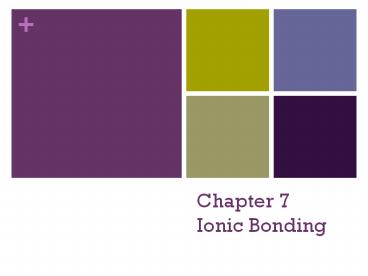Chapter 7 Ionic Bonding - PowerPoint PPT Presentation
Title:
Chapter 7 Ionic Bonding
Description:
Chapter 7 Ionic Bonding Bellringer Ions Remember: Cations positively charged atoms that have lost electrons Anions negatively charged atoms that have gained ... – PowerPoint PPT presentation
Number of Views:194
Avg rating:3.0/5.0
Title: Chapter 7 Ionic Bonding
1
Chapter 7Ionic Bonding
2
Bellringer
- Define a cation and an anion. Give one example
of each. - Cations
- Anions
3
Ions
- Remember
- Cations positively charged atoms that have lost
electrons - Anions negatively charged atoms that have
gained electrons - Valence Electrons electrons in the highest
occupied energy level of an atom - Octet Rule all atoms want to be like noble
gases and have 8 electrons
4
Vocabulary Activity
- Valence electrons
- Electron dot structures
- Octet rule
- Halide ions
- Cations
- Anions
- Ionic compounds
- Ionic Bonds
- Chemical Formula
- Formula Unit
- Coordination Number
- Metallic Bonds
- Alloys
- Ionization Energy
- Electronegativity
- Atomic Radii
- Alkali Metals
- Alkaline Earth Metals
- Halogens
5
Ionic Bond Formation
- Ionic Bond form between a metal cation and
nonmetal anion - To follow the octet rule, the cation gives up an
electron(s) to the anion, which bonds the two
ions together. - When the two ions bond, they become a neutrally
charged compound.
6
(No Transcript)
7
Electron Dot Diagrams
- Electron dot diagrams can be used to illustrate
how many valence electrons an atom has. - Examples
8
Fixed Charge Ionic Compounds Formula to Name
- Steps (MgS)
- The cation always comes first in the name
(magnesium) - The anion comes second in the name, and the
suffix -ide is added to the stem of the anion
name (sulfide) - Final name Magnesium sulfide
9
Fixed Charge Ionic Compounds Name to Formula
- Steps (Aluminum oxide)
- Write down the charge and symbol of the cation
(Al3) - Write down the charge and symbol of the anion
(O2-) - Remember that ionic compounds are neutral. Use
the necessary number of cations and anions to
balance the charges. (2 Al and 3 O) - Final formula Al2O3
10
Polyatomic Ion Nomenclature Formula to Name
- Rules Fe(NO3)2
- Decide if the cation shows variable change. If it
does, you will have to use a Roman numeral to
denote the charge. (Iron (II)) - Determine the name of the polyatomic ion.
(Nitrate) - Final name Iron (II) nitrate
- Ca(ClO3)2
- If the cation does not show variable change, you
do not need a Roman numeral (calcium) - Determine the name of the polyatomic ion
(chlorate). - Final name Calcium chlorate
11
Polyatomic Ion Nomenclature Name to Formula
- Rules (copper (II) chlorate)
- The first word provides the symbol of the cation
(Cu). - The Roman numeral provides the charge of the
cation (2). - The second word provides the symbol of the anion
(ClO3-). - Remember the charges need to balance out, so
provide the correct number of ions needed to gain
a neutral charge. - Final name Cu(ClO3)2































